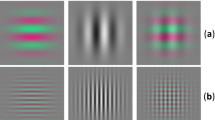Abstract
It is now generally accepted that the human visual system consists of subsystems (“channels”) that may be activated in parallel. According to some models of detection, detection is by probability summation among channels, while in other models it is assumed that detection is by a single channel that may even be tuned specifically to the stimulus pattern (detection by a matched filter). So far, arguments in particular for the hypothesis of probbbility summation are based on plausibility considerations and on demonstrations that the data from certain detection experiments are compatible with this hypothesis. In this paper it is shown that linear contrast interrelationship functions together with a property of a large class of distribution functions (strict log-concavity or logconvexity on the relevant set of contrasts/intensities) uniquely point to detection by a single channel. In particular, models of detection by probability summation based on Quick's Model are incompatible with linear contrast interrelationship functions. Sufficient (and observable) conditions for the strict logconcavity/log-convexity of distribution functions are presented.
Similar content being viewed by others
References
Abadi RV, Kulikowski JJ (1973) Linear summation of spatial harmonics in human vision. Vision Res 13:1625–1628
Bergen JR, Wilson HR, Cowan JD (1979) Further evidence for four mechanisms mediating vision at threshold: sensitivities to complex gratings and aperiodic stimuli. J Opt Soc Am 69:1580–1587
Bolthausen E (1987) Personal communication
Ditlivsen O (1971) Extremes and first passage times with applications in civil engineering. Dissertation. Technical University of Denmark, Copenhagen
Falmagne JC (1982) Psychometric functions theory. J Math Psychol 25:1–50
Feller W (1966) An introduction to probability theory and its applications, vol II. Wiley, New York London Sydney
Fisher RA, Tippett LH (1928) Limiting forms of the frequency distribution of the largest or smallest member of a sample. Proc Cambridge Phil Soc 24:180–190
Fleet DJ, Hallett PE, Jepson AD (1985) Spatiotemporal inseparability in early visual processing. Biol Cybern 52:153–164
Galambos J (1978) The asymptotic theory of extreme order statistics. Wiley, New York
Gnedenko MV (1943) Sur la distribution limite du terme maximum d'une serie aléatoire. Ann Math 44:423–453
Graham N (1977) Visual detection of aperiodic spatial stimuli by probability summation among narrow band channels. Vision Res 17:637–653
Green DM, Luce RD (1975) Parallel psychometric functions from a set of independent detectors. Psychol Rev 82:483–486
Hauske G, Wolf W, Lupp U (1976) Matched filters in human vision. Biol Cybern 22:181–188
Kulikowski JJ, King-Smith PE (1973) Spatial arrangement of line, edge and grating detectors revealed by sub-threshold summation. Vision Res 13:1455–1478
Leadbetter MR, Lindgren G, Rootzén H (1983) Extremes and related properties of random sequences and processes. Springer, New York Berlin Heidelberg
Marr D (1982) Vision. Freeman, San Francisco
Mostafavi H, Sakrison DJ (1976) Structure and properties of a single channel in the human visual system. Vision Res 16:957–968
Nachmias J (1967) Effect of exposure duration on visual contrast sensitivity with square wave gratings. J Opt Soc Am 57:421–427
Quick Jr, RF (1974) A vector-magnitude model for contrast detection. Kybernetik 16:65–67
Roberts AW, Varberg DE (1973) Convex functions. Academic Press, New York
Roufs JAJ, Blommaert FJJ (1981) Temporal impulse and step responses of the visual system obtained psychophysically by means of a drift-correcting perturbation technique. Vision Res XX:1203–1221
Sachs MB, Nachmias J, Robson JG (1971) Spatial-frequency channels in human vision. J Opt Soc Am 61:1176–1186
Sakitt B (1971) Configuration dependence of scotopic spatial vision. J Physiol 216:513–529
Shapley RM, Tolhurst DJ (1973) Edge detectors in human vision. J Physiol Lond 229:165–183
Wilson HR, Bergen JR (1979) A four mechanism model for threshold spatial vision. Vision Res 19:19–32
Author information
Authors and Affiliations
Rights and permissions
About this article
Cite this article
Mortensen, U. Visual contrast detection by a single channel versus probability summation among channels. Biol. Cybernetics 59, 137–147 (1988). https://doi.org/10.1007/BF00317776
Received:
Issue Date:
DOI: https://doi.org/10.1007/BF00317776




